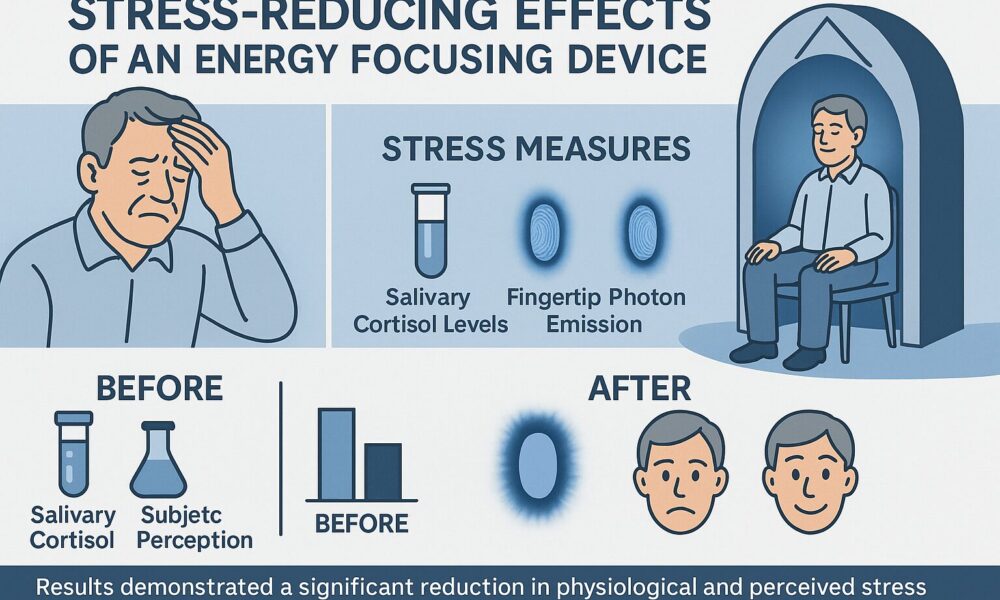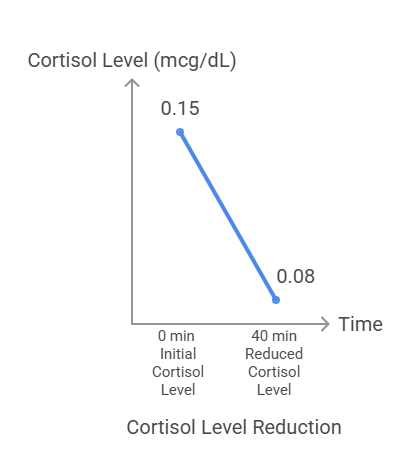Case Study: Evaluating the Stress-Reducing Effects of an Energy Focusing Device

Abstract
This case study examines the effects of an Energy focusing device (EFD) on stress levels in a 58-year-old male. The subject’s salivary cortisol levels, fingertip photon emission spectra, and subjective stress perception were assessed before and after a 40-minute session within the EFD. Results demonstrated a significant reduction in physiological and perceived stress markers, suggesting the device’s potential benefits for mental wellness.
Introduction
Stress is a well-documented factor contributing to various health concerns, including cardiovascular diseases, weakened immune function, and mental health disorders. Alternative therapies and energy-based interventions have gained increasing attention for their potential role in stress management. This case study explores the impact of a cylindrical energy focusing device (EFD) on stress reduction by analyzing salivary cortisol levels (1,2,3,4), BioWell stress metrics, and perceived stress assessments.
Methodology
Participant
A 58-year-old male participant, with no known chronic illnesses, volunteered for the study. The subject followed a regular daily routine and was not taking any medications or supplements known to impact cortisol levels.
Procedure
The study was conducted in a controlled indoor environment. The participant lay within the cylindrical EFD for a duration of 40 minutes.
Pre- and Post-Session Assessments
1) Salivary Cortisol Measurement: Saliva samples were collected before and after the session to quantify changes in cortisol, a primary biomarker of physiological stress using the Quest Diagnostics Salivary Cortisol test based on chromatography and mass spectrometry .
2) BioWell Analysis: The BioWell device was used to measure fingertip photon emission spectra, providing an objective metric of stress levels.
3) Perceived Stress Questionnaire: The subject completed a standardized questionnaire both before and after the session to assess subjective stress perception.
Results
1. Salivary Cortisol Reduction
The subject’s salivary cortisol level showed a nearly 50% decrease, dropping from 0.15 mcg/dL before the session to 0.08 mcg/dL post-session. This substantial decline indicates a significant reduction in physiological stress.

2. BioWell Stress Metrics
The BioWell energy scan revealed an approximately 10% decrease in stress levels post-session, aligning with the salivary cortisol findings.
3. Subjective Stress Perception
The participant reported a marked decrease in perceived stress based on questionnaire responses. Post-session, the subject described feeling notably more relaxed and mentally clear.
Discussion
The results suggest that exposure to the EFD may contribute to stress reduction, as evidenced by objective biomarkers and subjective self-reports. The significant drop in cortisol aligns with the BioWell stress analysis, reinforcing the physiological impact of the device. Additionally, the participant’s subjective experience further validates these findings.
While this case study presents compelling preliminary evidence, further research with larger sample sizes and controlled trials is necessary to validate the EFD’s efficacy and explore its underlying mechanisms.
Conclusion
This case study demonstrates that a 40-minute session within an aluminum cylindrical energy focusing device resulted in a substantial reduction in stress markers, including a 50% drop in salivary cortisol, a 10% decrease in BioWell stress metrics, and improved subjective stress perception. These findings support the potential of energy-focused interventions in stress management and mental wellness.
Future Research Directions
To further validate these findings, future studies should incorporate:
- A larger sample size for statistical significance.
- Randomized controlled trials to rule out placebo effects.
- Long-term assessments to evaluate sustained stress reduction.
This case study provides a foundation for further exploration of the physiological and psychological benefits of energy focusing devices in stress management.
- Ahmed, T., Powner, M. B., Qassem, M., & Kyriacou, P. A. (2024). Rapid optical determination of salivary cortisol responses in individuals undergoing physiological and psychological stress. Scientific Reports, 14(1). https://doi.org/10.1038/s41598-024-69466-5
- Crnković, D. (2018). Correlation between salivary biochemical stress indicators and psychological indicators. Acta Clinica Croatica, 57(2). https://doi.org/10.20471/acc.2018.57.02.13
- Quest Diagnostics: Test Directory. (n.d.). https://testdirectory.questdiagnostics.com/test/test-detail/93020/cortisol-lcms-saliva-2-samples?p=r&q=Cortisol,%20LC%2FMS,%20Saliva,%204%20Samples&cc=MASTER
- Rubik, B., Muehsam, D., Hammerschlag, R., & Jain, S. (2015). Biofield Science and Healing: History, Terminology, and Concepts. Global Advances in Health and Medicine, 4(1_suppl), gahmj.2015.038. https://doi.org/10.7453/gahmj.2015.038.suppl
Source: Case Study: Evaluating the Stress-Reducing Effects of an Energy Focusing Device




